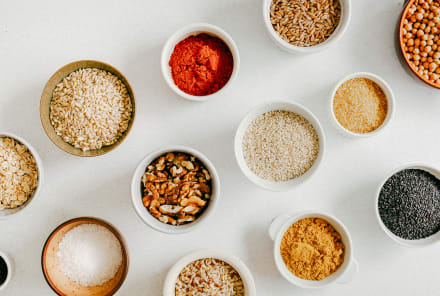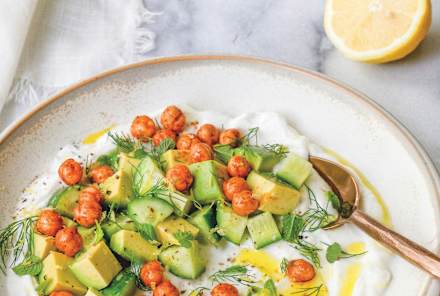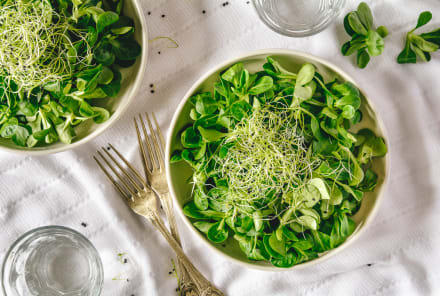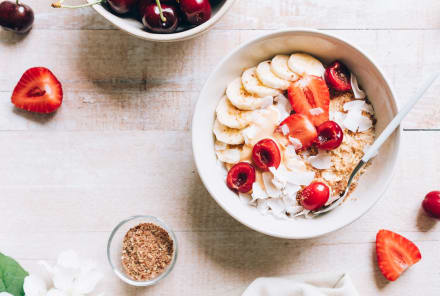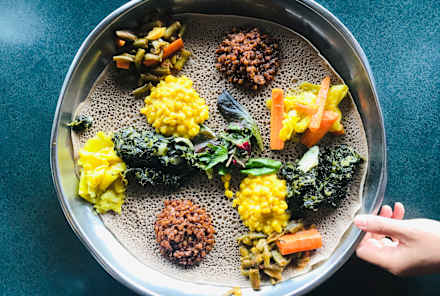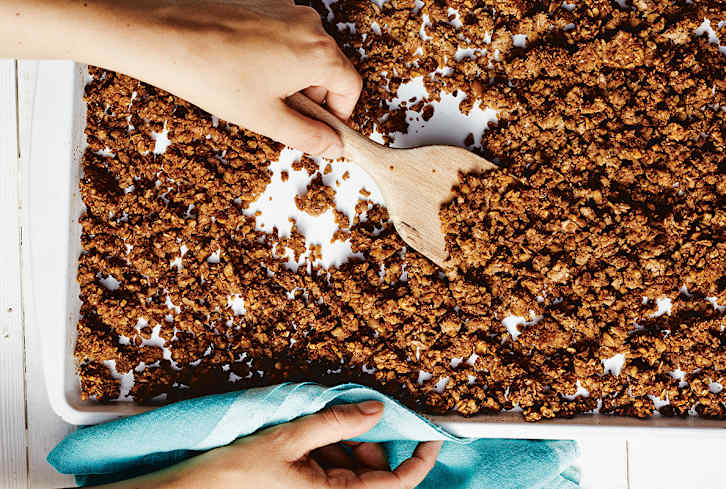Advertisement
The 8 Best Nuts For Protein & Delicious Ways To Eat More Of Them

For those looking to up their protein game, nuts are an excellent food to keep around. Not only are nuts high in protein, but they're packed with fiber, healthy fats, vitamins, minerals, and phytochemicals. Some nuts are more concentrated in protein than others, making them a smarter choice for those who want to boost their intake of this important nutrient.
In this article, we're sharing eight of the best nuts for protein, plus easy and delicious ways to incorporate more nuts into your diet.
Why nuts are a great protein source
Nuts really are plant-based perfection. They provide healthy fats and fiber, a variety of vitamins and minerals, as well as all-important protein.
In case you haven't heard, protein is a pretty big deal. Your body requires a consistent supply of amino acids, aka the building blocks of proteins, in order to perform vital functions like creating hormones and neurotransmitters, absorbing nutrients, and building muscle. In order to meet this demand, your diet should be high in a variety of protein-rich foods. (Here's more on how much protein you need daily.)
Unlike many protein sources like meat and eggs that need to be refrigerated and cooked, nuts are a portable source of protein that can be taken on the go and stored in your kitchen, work desk, and even your car so you're never without a filling snack option.
Plus, nuts pair well with both sweet and savory ingredients and can be added to salads, grain dishes, baked goods, granola, cereal, and even desserts for a healthy boost of protein.
FYI, the USDA-recommended serving size for nuts is 1 ounce, which equates to ¼ cup or a small handful.
The best nuts for filling your protein needs
While all nuts contain protein, some are a richer source than others. Here are eight of the highest-protein nuts, in order of protein count per ounce:
| Nuts | Protein | Calories | Fat | Carbs | Fiber |
|---|---|---|---|---|---|
| Peanuts (1 oz) | 7.43 grams | 162 | 14.1 grams | 4.48 grams | 2.69 grams |
| Almonds (1 oz) | 6.01 grams | 164 | 14 grams | 6.12 grams | 3.54 grams |
| Pistachios (1 oz) | 5.95 grams | 162 | 13 grams | 8.02 grams | 2.92 grams |
| Cashews (1 oz) | 4.34 grams | 163 | 13.2 grams | 9.27 grams | 0.85 gram |
| Hazelnuts (1 oz) | 4.25 grams | 183 | 17.7 grams | 4.99 grams | 2.66 grams |
| Brazil nuts (1 oz) | 4.05 grams | 187 | 19 grams | 3.32 grams | 2.13 grams |
| Walnuts (1 oz) | 4 grams | 180 | 17 grams | 5.01 grams | 1.99 grams |
| Pine nuts (1 oz) | 3.88 grams | 191 | 19.4 grams | 3.71 grams | 1.05 grams |
Peanuts
7.43 grams of protein (per ounce of roasted peanuts)
Although they're technically classified as legumes, most people think of peanuts as nuts. Peanuts are commonly found mixed with other nuts like almonds and cashews in products like trail mix and flavored mixed nuts.
Peanuts and peanut butter are packed with plant-based protein, plus fiber, healthy fats, and vitamins and minerals, such as vitamin E and copper. Copper1 is a mineral that plays important roles in energy production, immune function, and cellular defense.
Chopped peanuts can be sprinkled on dishes like oatmeal and salads, and peanut butter can be used to add a quick source of protein to both sweet and savory recipes like chia pudding, peanut noodles, and soups.
- Calories: 162
- Protein: 7.43 grams
- Fat: 14.1 grams
- Carbs: 4.48 grams
- Fiber: 2.69 grams
Standout benefits
Almonds
6.01 grams of protein (per ounce of whole almonds)
Almonds are a smart choice if you're looking to up your protein game. Whole almonds provide 6 grams of filling protein per ounce and are also packed with vitamins and minerals, like magnesium.
Magnesium is a nutrient that's needed for the regulation of blood sugar and blood pressure and helps your body handle stress. Unfortunately, most people's diets3 are low in this important mineral, which can negatively impact physical and mental health. Adding just 1 ounce of almonds to your daily diet will cover 18% of your daily needs for magnesium.
Chopped and sliced almonds are delicious in salads, and ground almonds can be used in baked goods and as a low-carb breading for fish and chicken. Roasted almonds can be paired with fresh or dried fruit to make a filling and easy snack.
- Calories: 164
- Protein: 6 grams
- Fat: 14 grams
- Carbs: 6.12 grams
- Fiber: 3.54 grams
Standout benefits
Pistachios
5.95 grams of protein (per ounce of roasted pistachios)
These green-hued gems are brimming with protein. "As a performance dietitian, pistachios are one of my favorite nuts since they provide nearly 6 grams of complete protein per serving. I also love that they offer 3 grams of fiber, and nearly 90% of the fats in pistachios are unsaturated," Kelly Jones, M.S., R.D., CSSD, LDN, tells mindbodygreen.
In addition to being a great source of protein, pistachios are rich in minerals important to blood pressure regulation, like potassium.
A 2021 review of 21 studies published in the American Journal of Clinical Nutrition found that, out of all of the nuts included in the review, pistachio intake had the strongest effect on reducing both systolic5 (the top number) and diastolic (the bottom number) blood pressure.
Because it's under-consumed by so many people, potassium is considered a "nutrient of public health concern" by the U.S. Department of Health and Human Services. This means that most people can benefit from eating more potassium-rich foods like pistachios. To make a sweet and salty protein- and fiber-packed snack, mix 1 ounce of pistachios with a small handful of dried cherries.
- Calories: 162
- Protein: 5.95 grams
- Fat: 13 grams
- Carbs: 8.02 grams
- Fiber: 2.92 grams
Standout benefits
Cashews
4.34 grams of protein (per ounce of roasted cashews)
Cashews have a buttery taste and creamy texture, making them a tasty choice for snacking, baking, and just about any other culinary use you can think of. They can even be blended with collagen, some dates, and coffee to make the creamiest dairy-free coffee beverage you've ever tasted.
Studies show that noshing on cashews regularly can majorly benefit heart health by reducing levels of triglycerides7, insulin, blood pressure, and LDL cholesterol8. This is due to the high level of heart-healthy nutrients like fiber and minerals, as well as anti-inflammatory and antioxidant compounds found in cashews.
- Calories: 163
- Protein: 4.34 grams
- Fat: 13.2 grams
- Carbs: 9.27 grams
- Fiber: 0.85 gram
Standout benefits
Hazelnuts
4.25 grams of protein (per ounce of roasted hazelnuts)
Hazelnuts are a popular ingredient in desserts like baked goods and chocolate candies, but they're also delicious when eaten on their own and when incorporated into savory recipes. They're rich in protein, fiber, and healthy fats, as well as vitamin E, vitamin K, and the mineral manganese10, which is involved in immune response, bone health, and metabolism.
Hazelnuts are an excellent source of phenolic antioxidants11 like gallic acid, epicatechin, caffeic acid, p-hydroxybenzoic acid, sinapic acid, and quercetin, which have powerful cellular protective and anti-inflammatory effects in the body.
If you're in the mood for something sweet, try using hazelnuts to make these no-bake hazelnut fudge brownies, which deliver a powerful dose of antioxidants in every bite thanks to ingredients like hazelnuts, walnuts, and cocoa powder.
- Calories: 183
- Protein: 4.25 grams
- Fat: 17.7 grams
- Carbs: 4.99 grams
- Fiber: 2.66 grams
Standout benefits
Brazil nuts
4.05 grams of protein (per ounce of dried Brazil nuts)
Brazil nuts are a good source of protein, fiber, vitamins, and minerals like copper, magnesium, and zinc, but they're best known for being one of the richest sources of dietary selenium you can eat. Selenium is a mineral that's needed for the functioning of special types of proteins called selenoproteins13, which play critical roles in thyroid health, reproductive health, and more.
- Calories: 187
- Protein: 4.05 grams
- Fat: 19 grams
- Carbs: 3.32 grams
- Fiber: 2.13 grams
Standout benefits
Walnuts
4 grams of protein (per ounce of roasted walnuts)
Walnuts are a staple in many people's diets, and they're commonly added to dishes like oatmeal, cereals, salads, and yogurt parfaits. Their slightly sweet, mild taste makes them a go-to ingredient for baked goods like cookies and cakes. Walnuts are often recommended as a natural way to boost heart health due to their ability15 to reduce blood fat levels, improve blood vessel function, and lower blood pressure.
Try using whole walnuts in snack mixes and sprinkling chopped walnuts onto salads. Walnuts can even be combined with avocado, arugula, and a few other simple ingredients to create a creamy, veggie-packed pesto.
- Calories: 180
- Protein: 4 grams
- Fat: 17 grams
- Carbs: 5.01 grams
- Fiber: 1.99 grams
Standout benefits
Pine nuts
3.88 grams of protein (per ounce of dried pine nuts)
Pine nuts are the seeds of pine trees, but they're classified as nuts by the FDA. They have a pine-like flavor and soft texture and are packed with nutrients like vitamins and minerals.
Just 1 ounce of pine nuts covers over 15% of your daily needs for vitamin E, magnesium, copper, manganese, and zinc. They're also a good source of health-promoting antioxidants17 like phytosterols and carotenoids, which protect against cellular damage and may help lower disease risk.
Try using pine nuts to make this flavorful pine nut pasta sauce or use them to add texture to your favorite plant-based bites like this portobello mushroom burger recipe.
- Calories: 191
- Protein: 3.88 grams
- Fat: 19.4 grams
- Carbs: 3.71 grams
- Fiber: 1.05 grams
Standout benefits
How to work more nuts into your diet
There are so many ways to incorporate more nuts into snacks, meals, and healthy desserts.
Studies show that people who eat more nuts have lower rates of common health conditions like heart disease and certain cancers. In fact, a 2022 review published in Advances in Nutrition found that a daily intake of 1 ounce of nuts19 was associated with a 21% reduced risk of heart disease, a 22% reduction in death from all causes, and an 11% reduction in cancer-related death.
Plus, adding more nuts to your diet is an easy way to bump up your intake of nutrients that are commonly lacking in most people's diets, like fiber, potassium, and magnesium.
OK, so now that you know just how healthy nuts really are, here are a few ways to work more nuts into your diet:
- Add nuts to your favorite snacks and meals: "Nuts are one of the easiest foods to add into your diet because you can grab a handful and add them to any meal or snack," Abby K. Cannon, J.D., R.D., CDN, tells mindbodygreen. She suggests storing them in glass jars in the fridge or pantry where you can easily see them. "This makes them easy to grab and reduces the chances you'll forget about them," she says.
- Use nuts to coat chicken cutlets, fish, and veggies: For a low-carb alternative to bread crumbs, pulse nuts like almonds in a food processor and use them to make a crispy coating for proteins like chicken and fish. "Pistachio- or pecan-crusted salmon is a favorite recipe of mine," says Jones.
- Use nut-based flours in your favorite baked goods: Compared to white flour, nut-based flours like almond flour are higher in protein, healthy fats, and fiber. Try recreating your favorite muffin, cookie, cake, and bread recipes using almond flour for added nutrients.
- Make protein- and fiber-rich energy bites: "I use my food processor to blend nuts with dates or dried fruit to make energy bites almost weekly for on-the-go snacks," says Jones.
- Use nut butter to make nutritious sweets: Peanut butter and almond butter can be used to make filling and delicious sweet treats, like these vegan peanut butter truffles.
- Make your own nutty trail mix and granola: Store-bought granola and snack mixes can be packed with added sugar. Try making your own versions at home, like this cardamom and ginger granola.
- Keep mixed nut packs on hand for a healthy, portable snack: You can buy single-serve packets of mixed nuts and store them in your desk at work, in your car, or in your bag. Having a protein-rich snack at the ready can come in handy when you're on the cusp of getting hangry. "I always have single-serve packages of shelled chili-roasted pistachios with me when I travel," says Jones.
- Use them in pestos and gremolatas: Nuts like pine nuts, walnuts, and pistachios make delicious pestos and can be added to gremolatas, a combination of garlic, parsley, and lemon zest that's delicious on pasta, veggies, and meat dishes.
These are just a few ways to add more nuts to your diet. Nuts can be added to a variety of recipes, so don't be afraid to experiment in the kitchen with chopped nuts, nut-based flour, and nut butter.
FAQ
What nuts are best for building muscle?
Protein is the most important nutrient for muscle growth and repair. Adding high-protein nuts like almonds and pistachios to your diet helps deliver the amino acids your body needs to build muscle and promote overall health.
Which nuts have the most protein and least fat?
All nuts are high in fat, but peanuts contain less fat than most nuts. One ounce of roasted peanuts contains 7.43 grams of protein and only 14.1 grams of fat. In general, there's no need to worry about the fat in nuts, or the fat in most other foods, for that matter. Fat is an essential nutrient, and adding healthy sources of fat to your diet, like nuts, is important for energy, brain health, hormonal health, and more.
The takeaway
If you're looking for an easy and delicious way to bump up your protein intake, consider making a trip to your local grocery store to stock up on nuts. Not only are nuts a good source of protein, but they provide essential vitamins and minerals, healthy fats, fiber, and protective plant compounds. Plus, research shows that diets rich in nuts can help protect against common health conditions like heart disease.
Oh, and did we mention they're delicious? To reap the major health benefits of nuts, try them out in simple recipes like this vegan-friendly pesto or this protein-packed aioli shrimp with walnuts.
19 Sources
- https://ods.od.nih.gov/factsheets/Copper-HealthProfessional/
- https://fdc.nal.usda.gov/fdc-app.html#/food-details/174263/nutrients
- https://www.ncbi.nlm.nih.gov/pmc/articles/PMC5786912/
- https://fdc.nal.usda.gov/fdc-app.html#/food-details/170567/nutrients
- https://academic.oup.com/ajcn/article/101/5/966/4577579
- https://fdc.nal.usda.gov/fdc-app.html#/food-details/170185/nutrients
- https://www.ncbi.nlm.nih.gov/pmc/articles/PMC6573847/
- https://pubmed.ncbi.nlm.nih.gov/28356271
- https://fdc.nal.usda.gov/fdc-app.html#/food-details/170571/nutrients
- https://ods.od.nih.gov/factsheets/Manganese-HealthProfessional/
- https://www.ncbi.nlm.nih.gov/pmc/articles/PMC6637671/
- https://fdc.nal.usda.gov/fdc-app.html#/food-details/170583/nutrients
- https://ods.od.nih.gov/factsheets/Selenium-HealthProfessional/
- https://fdc.nal.usda.gov/fdc-app.html#/food-details/170569/nutrients
- https://www.ncbi.nlm.nih.gov/pmc/articles/PMC3652880/
- https://fdc.nal.usda.gov/fdc-app.html#/food-details/170594/nutrients
- https://www.ncbi.nlm.nih.gov/pmc/articles/PMC6600560/
- https://fdc.nal.usda.gov/fdc-app.html#/food-details/170591/nutrients
- https://www.ncbi.nlm.nih.gov/pmc/articles/PMC9776667/

Why Nutrition Is Key To Changing Your Relationship With Alcohol
Brooke Scheller, DCN, CNS

Why Alcohol Sabotages Your Gut Health & How To Get Back On Track
Brooke Scheller, DCN, CNS

Why Nutrition Is Key To Changing Your Relationship With Alcohol
Brooke Scheller, DCN, CNS

Why Alcohol Sabotages Your Gut Health & How To Get Back On Track
Brooke Scheller, DCN, CNS

Why Nutrition Is Key To Changing Your Relationship With Alcohol
Brooke Scheller, DCN, CNS

Why Alcohol Sabotages Your Gut Health & How To Get Back On Track
Brooke Scheller, DCN, CNS

Why Nutrition Is Key To Changing Your Relationship With Alcohol
Brooke Scheller, DCN, CNS

Why Alcohol Sabotages Your Gut Health & How To Get Back On Track
Brooke Scheller, DCN, CNS
